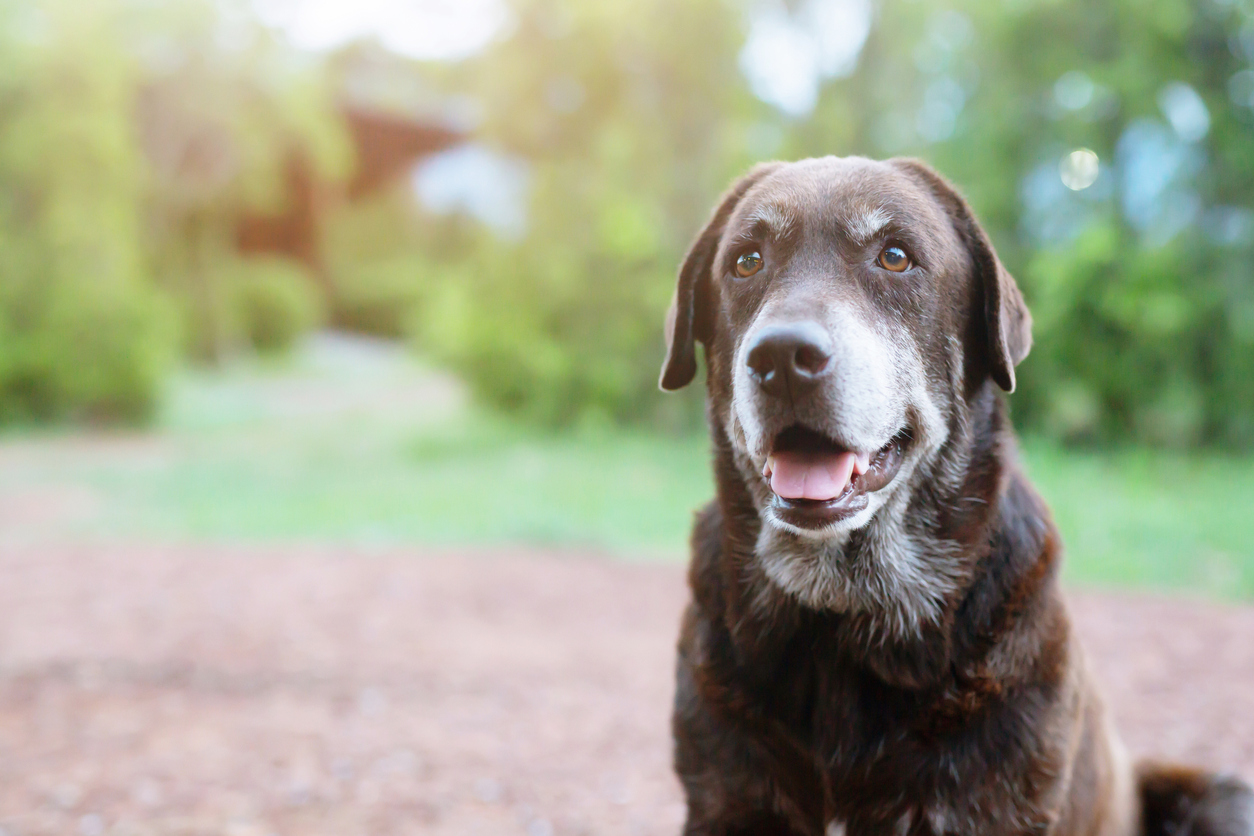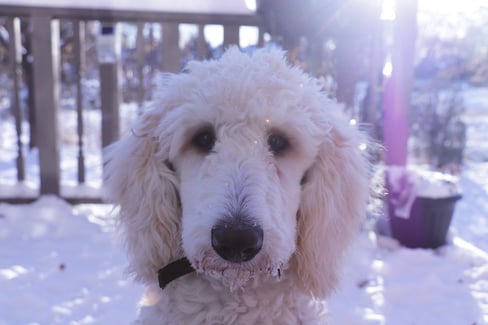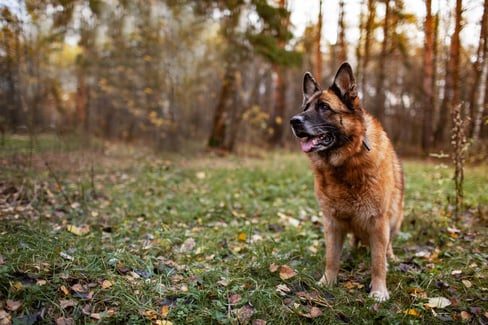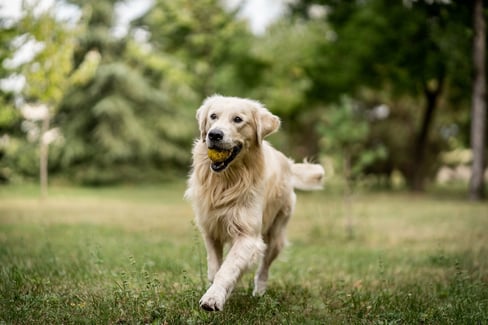Table of Contents
Dogs are amazing creatures. We love them, we care for them, and we want to make sure they're happy and healthy for as long as possible. One way that we can support our dog’s health is by knowing the warning signs of various ailments and illnesses. You may have heard about hip dysplasia before, and could be wondering, “What is hip dysplasia in a dog?”, especially if you’re concerned that your pup may be suffering with the condition.
If your dog seems to be having trouble walking without pain or discomfort, there's a chance they may have hip dysplasia—a condition that plagues as many as 15% of all dogs in Canada and the USA. However, there are several treatment options out there to help a dog with hip dysplasia, and all of them can help keep your pup moving comfortably through their golden years!
Dog Hip Displacement vs Dog Hip Dysplasia
When it comes to your pup's joint and hip health, there are plenty of terms that get tossed around, so it's totally understandable that you may get things confused from time to time!
A dog hip displacement occurs when the ball part of the joint pops out of the socket suddenly, often due to blunt trauma. In dogs with hip dysplasia, on the other hand, the upper thigh ball portion of the hip socket is not fully covered during hip socket growth. This results in an incongruous joint, causing your dog discomfort and pain when they walk.
The image below shows what a typical dog hip bone looks like versus one with dysplasia:
Hip dislocations can happen to even the strongest dogs when there is enough force, but dogs with hip dysplasia are at higher risk for this injury so it's important to keep tabs on especially large breed dogs as they grow. Don't be afraid to ask your vet some questions if you're concerned about the way your pup is moving.
Signs of Dog Hip Dysplasia
You might think that dog hip dysplasia would be easy to spot, but that’s not always the case. This is one of those dog hip issues that can be confused with other joint issues, such as arthritis. However, if you do recognize some of the signs listed below, it’s time to bring your dog to your vet for an x-ray:
Chronic or Occasional Lameness
When you have a lame dog, it means that they are unable to use one or more of their limbs properly. This could present in a variety of ways, from not being able to rise from a laying down position properly or having trouble walking. A dog with hip dysplasia, as you’d imagine, has issues with their hindquarters (back dog legs) specifically.
Limping with no Previous Trauma or Injury
If you see your dog limping, it could be a sign that they have a joint issue that needs to be addressed—including hip dysplasia.
In some cases, lameness can go away with rest, pain treatment, and use of joint supplements. But if your dog continues to exhibit symptoms of lameness, further treatment, including surgery, may be needed.
Cracking and Popping Sounds from the Hip Joint
Considering that hip dysplasia occurs when the femoral head (the top part of your dog’s leg that connects to the hip joint) slides or moves completely out of place, it’s not unusual to hear cracking and popping sounds coming from your dog’s hip joint when this happens. These sounds occur because the femoral head on your dog’s leg is rubbing against the hip joint. In some cases, this friction can cause bone chips, which may need to be removed by your vet via surgery to prevent infection.
“Bunny Hopping” When Running
The term “bunny hopping” refers to when a dog lifts their affected leg and sort of hops along when they are trying to run or even walk in an attempt to prevent further pain. If your dog is constantly holding a leg up and not putting any pressure on it at all, it could be a sign that the femoral head has completely dislocated from the hip. With hip dysplasia, however, they will sometimes put their leg down and might be able to walk or run on it for a few steps before having to lift it again due to pain.
Trouble Standing
When standing or rising from a sitting position into a standing position, you may notice that your dog either hesitates or shifts their weight. This is because the pain in their hips prevents them from making that smooth movement from sitting to standing, and prevents them from being able to stand on all four of their legs for an extended period of time.
Abnormal Sitting Positions
Similar to issues with standing, you may notice your dog shift their weight when sitting, or avoid putting pressure on one of their hind legs altogether. This can result in some strange positions in a dog sitting with hip dysplasia as they move around in an attempt to get more comfortable.
Having Trouble Getting Off Furniture or In Cars and Jumping
If you’ve noticed that your pup has suddenly stopped jumping into the car in excitement of getting to go on a car ride and instead you have to lift them up into your vehicle, it’s a telltale sign that something could be wrong with their hips. Since the hips are key for your dog being able to jump up, when they are not in the correct position, your dog may not be able to complete the jump or jump without showing signs of being in pain.
Causes of Dog Hip Dysplasia
Now that you know what to look for when it comes to hip dysplasia in dogs, you’re probably wondering about the potential causes of the condition.
Genetics
While all dogs are born with normal hips, usually around week three development of hip dysplasia begins in dogs that have genetic predisposition to the disorder. In dog breeds with hip dysplasia due to genetics, a certain gene on chromosome 11 is missing, causing issues with the connective tissues around the hip joint, leading to malformation as the puppy grows.
Hip dysplasia is more prevelant in larger breeds versus smaller breed dogs, because the excessive growth rate and subsequent rapid weight gain characteristic of large dogs makes it easier for the ball and socket part of the hip joint to not develop properly.
Poor Diet
A poor diet can also contribute to the development of malformed hips. Excess weight gain is one of the most common ways that excess pressure can be put on the hips, exacerbating any issues that may not have been as obvious before. Further, a diet that doesn’t have the correct nutrients for your dog’s life stage can negatively affect their bone, muscle, and joint tissue development.
To find a high-quality dog food, there are a few tips that you can follow:
- Look for food with a statement about being nutritionally complete. The food should indicate whether it’s fine to feed as your dog’s main diet, or be given to them as an occasional treat.
- Look for meat ingredients (dog food ingredients are listed from most to least on the label). Meat or poultry should be listed first, followed by byproducts. Meat or poultry byproducts are things like trimmings and organs, while anything listed as meat or poultry refers to flesh. Be wary of “meat byproduct meals” however, as they may not be actual meat—rather the stomach contents, fur, or feathers of the animal.
- The food should contain essential nutrients. Dogs need more than just meat, they need calcium, phosphorus, vitamin D, and more to maintain their overall health. Other ingredients like cranberries, blueberries, and pumpkin can also help with their digestive health.
Poor Environmental Conditions
Since dog hip dysplasia can develop as a result of arthritis or trauma to the hip joints, environmental conditions, including where the dog spends most of their time, can cause the condition to worsen. If a dog is being kept outside on hard ground (compact dirt or pavement) and not given a soft place to lay down and a shelter to protect them from the elements, hip dysplasia symptoms are likely to worsen.
Overexertion (Work or Exercise)
If a person works a laborious job constantly, it eventually takes a toll on their joints. The same goes for dogs. An overworked pup will eventually develop joint issues that can significantly affect their ability to continue their work in the future. Ensuring that your pup gets regular breaks and feeding them a healthy diet that incorporates a high-quality joint supplement like TRI-ACTA H.A. helps ensure that they are able to continue herding animals, being a sled dog, or doing whatever other kind of work they were born to do.
TRI-ACTA H.A. for Pets
Our maximum strength formula is optimally designed to accelerate the formation of cartilage, minimize inflammation, expedite the healing process, and improve joint conditions.
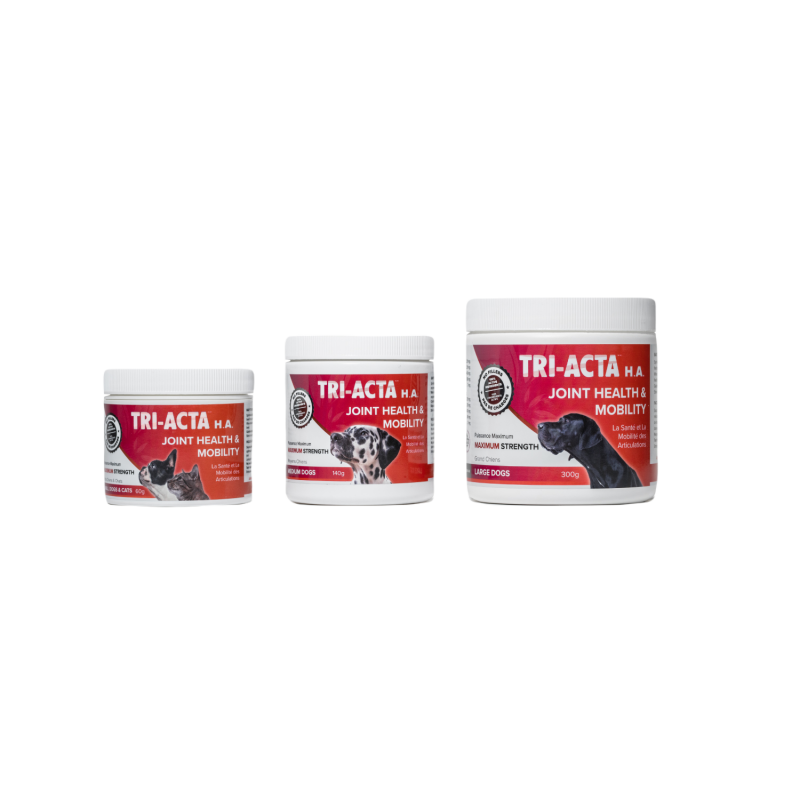
Other Dog Hip Issues to Watch Out for
While we’re on the topic of hip dysplasia, it’s a good time to learn about other dog hip issues so you can have the information you need to differentiate one concern from another.
Some of these include:
- Arthritis
- Legg-Calve-Perthe disease
- Osteochondrosis
- Hip dislocation
We're going to get into some background information that can help you better understand common conditions that could be the culprit behind your pup's hip pain.
Issue #1: Dog Arthritis
When we’re talking about joint conditions like hip dysplasia, dog arthritis is never far from our minds.
Both can impact your dog’s hips and by extension, their mobility. In arthritis, there is significant inflammation of the joints, caused by worn down cartilage or excess wear and tear on the joints. It can make walking difficult for your dog and cause pain when they attempt to move their legs.
Arthritis symptoms include:
- Limping
- An inability to get up after lying down or sitting
- Stiffness when moving around
Arthritis symptoms can be mild or severe. If your dog is showing any of these signs, it’s a good idea to talk to your vet about how best to treat them. Arthritis is a progressive disease, meaning that it gets worse over time. And if left untreated, the symptoms can become more severe and painful for your dog.
Some dogs may get arthritis from old age or because of an injury. And it’s especially not uncommon for large breed dogs to develop arthritis as they get older, especially if they are overweight or lack regular exercise in their lives. In some cases, a dog can be born with joint problems that cause them to develop arthritis early in life.
Issue #2: Legg-Calve-Perthes Disease
Legg-Calve-Perthes disease is a condition that affects the hip joints of young dogs. It is caused by a lack of blood supply to the femoral head (the ball at the top of the thigh bone), which spontaneously degenerates. This results in the collapse of the hip, leading to pain and lameness.
Legg Calve Perthes disease, while mostly mysterious in cause, has been linked to small dogs under 20 pounds and other genetic factors.
To diagnose Legg-Calve-Perthes, x-rays are needed. As the hip changes over time, multiple repeated radiographs are sometimes needed to gauge progression and other damage.
Issue #3: Osteochondrosis
Osteochondrosis is a disorder that involves cartilage in the dog's joints. This disease can occur at the ends of long bones, such as in the hip or knee, but it most commonly appears in the elbow joint and generally affects large-breed dogs.
Osteochondrosis may be found in young and adult puppies, but it often becomes evident during your pet's adolescence (between 6 months old and 2 years). In some cases, osteochondrosis causes little to no symptoms. However, if left untreated it can lead to permanent lameness or even arthritis down the road.
The cause of osteochondrosis is unknown—however, there are several common factors that seem to contribute to it:
- Genetics
- Obesity
- Rapid growth spurts
- Trauma/injury during exercise or playtime with other animals
- An imbalance between nutrients consumed in their diet
Issue #4 Hip Dislocation
While hip dislocation, also referred to as hip luxation, in dogs is most commonly caused by trauma, such as being hit by a vehicle, certain joint conditions, including arthritis, Legg-Calve-Perthes disease, and of course hip dysplasia can significantly increase the risk of hip dislocation.
If your dog has dislocated their hip, there are some telltale symptoms you will observe:
- Not being able to bear weight on their back leg (the one that has been dislocated from the hip)
- Limping and carrying the affected leg so it doesn’t touch the ground
- The affected leg may appear shorter than your dog’s other legs due to muscle contraction
- The affected hip joint may appear swollen and feel warm to the touch
To diagnose hip dislocation in dogs, your vet will take an x-ray to view the positioning of your dog’s hip joints. In the majority of cases, your dog will experience either craniodorsal displacement (when the bone slides forward and up) or ventrocaudal displacement (when the bone slides backwards and down).
Your vet will also be able to determine whether your dog’s hip bone has any malformation (hip dysplasia) or has another condition like Legg-Calve Perthes disease that affects the hip’s ability to keep the leg in place.
Ligaments can also potentially tear during a hip dislocation, which would need to be repaired surgically by your veterinarian. Bone chips may also occur due to the friction of the bones rubbing together, which your veterinarian may also have to surgically remove to prevent infection and irritation.
How to Prevent Dog Hip Dysplasia
Now that you know what dog hip dysplasia is, it's time to look at ways of preventing the condition in the first place. That way, you can enjoy more happy, healthy years with your pup.
Just a note though – as much as we try to prevent hip dysplasia, there is sometimes nothing we can do to prevent this condition from taking effect.
With that disclaimer in mind, you can check out our prevention and care tips to help avoid serious dog hip dysplasia treatment down the road.
Prevention Tip #1: Balance Their Diet
Regarding diet, there are 3 main priorities for preventing hip dysplasia in dogs:
- Feeding the right ingredients and vitamins
- Feeding the right quantity of food
- Manage obesity with the right dog diet
The first step to preventing hip dysplasia in your dog is to ensure that they get the right nutrients and vitamins.
To support healthy joints and muscles, you should feed your dog a high-quality diet that includes:
- Protein
- Fats
- Water
- Vitamins
- Minerals
- Carbohydrates
In terms of portion control, if you're feeding a commercial pet food that isn't labeled “low calorie” or “diet” then stick with what's recommended on their packaging as an estimate for how much they should eat each day, for their size and breed. Too much uncontrolled eating as puppies can lead some large breed dogs to have hip issues later in life.
You can also feed a specialty diet such as a raw food diet for dogs or opt for cooked, homemade doggie dishes to give them some variety. Just remember that any DIY misses the professional analysis of ingredients for the right balance of nutrients—so use extra caution.
Finally, managing your dog’s weight is also key to reducing dog hip dysplasia symptoms. The more weight bearing down on your pup’s hips—the harsher the pain from hip dysplasia will be. Managing your dog’s weight can be challenging, but offering diet food for overweight pups can be a simple way to get started. You can also consult your dog-tor for some more information about helping your beloved companion lose weight for good!
Prevention Tip #2: Consider Lineage
A good way to prevent hip dysplasia in your dog is by considering lineage. Lineage is extremely important when it comes to determining whether a dog will develop this condition or not.
Many breeders take hip scores of their animals into consideration before selling them off as puppies. The scores, ranging from 0 to 106 (0 to 53 for each hip), indicate the degree of hip dysplasia. If a parent has poor scores, then there's a chance that their offspring could also experience hip dysplasia, too. Because of all these reasons (and more), we highly recommend considering who exactly produced your puppy before buying, especially if they're purebred.
Prevention Tip #3: Include a Dog Supplement
Protect your dog from the inside and out! By feeding your pup supplements for dogs with hip dysplasia that include glucosamine for dogs, they can improve their joint health and have less pain from their dog hip dysplasia symptoms.
TRI-ACTA for Pets
A proactive approach for developing and younger adult pets to maintain optimal joint health mobility, minimize inflammation and fend off age-related ailments.
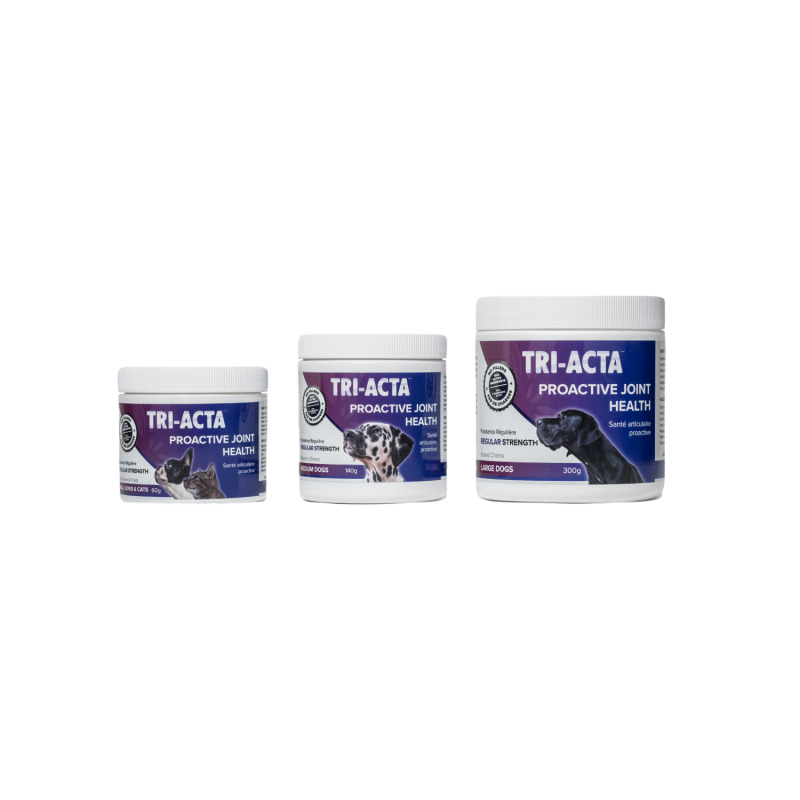
Since hip dysplasia in dogs is largely related to joint structure and health, certain ingredients can help reduce pain and improve the quality of your dog’s cartilage.
The table below shows some of the best ingredients to look for in dog hip dysplasia supplements.
|
Ingredient in Dog Hip Dysplasia Supplement |
Benefit |
|
Chondroitin sulfate |
An essential nutrient that helps repair cartilage, which is the connective tissue between bones in joints. Chondroitin also has anti-inflammatory properties and is known to assist in repairing and regenerating damaged joints and cartilage. |
|
Glucosamine |
Benefits your dog by assisting in rebuilding damaged joints while reducing inflammation associated with degeneration caused by injury over time due to their condition. |
|
MSM |
Reduces pain and inflammation caused by dog hip dysplasia. |
Prevention Tip #4: Exercise Carefully
Exercise is important for dogs with hip dysplasia. However, it's important to choose low-impact exercises that don't put too much strain on their hips, as certain activities can cause the joint cartilage to wear out faster than usual in your dog's hip joints, which can lead to further problems with hip dysplasia.
Some guidelines on dog hip dysplasia exercises:
- Choose low-impact exercises like swimming
- Exercise that's too intense, especially anaerobic exercises like running and jumping during fetch that drain energy stores quicker, can cause hip problems in dogs.
- Regularly exercise in shorter intervals, so your dog avoids overdoing it
- Use caution when throwing frisbees and tennis balls as slips and hyperextensions are most common during those activities.
4 Dog Hip Dysplasia Treatment Options
The condition of hip dysplasia is a painful one, but it doesn't have to be an all-consuming one. As long as you know what to watch out for and can get your dog treatment quickly, it's possible to prevent further damage or even reverse the condition altogether.
And when that’s not pawsible you can rest assured that there are well-known, commonly performed surgeries that can help provide dog hip dysplasia treatment that can leave your pup feeling rejuvenated and spry post-recovery.
Juvenile Pubic Symphysiodesis
An inexpensive, minimally invasive, prophylactic procedure, juvenile pubic symphysiodesis (JPS) is performed on immature dogs at risk of arthritis-related dog hip dysplasia.
In this procedure, the surgeon creates a premature closure of the pubic symphysis through electrocoagulation (which is basically a procedure that uses heat from an electric current to destroy abnormal tissue). When this growth is stopped, a type of rotation occurs in the joint, resulting in better coverage of the femur.
You can expect the following things post-op from this dog hip dysplasia treatment:
- A return to normal activity within two weeks of surgery, but you should avoid strenuous exercise for six weeks after surgery.
- Pain medication and antibiotics are given after surgery to reduce swelling and pain while healing occurs.
- Your vet may also suggest physical therapy exercises to help restore range of motion in their hips so they can walk normally again once healed.
Surgery
It's not always possible to treat hip dysplasia in dogs before symptoms start to show. Sometimes, your dog may require surgery later in life if you didn't catch the condition early on.
Good news! These surgeries are extremely common and help your dog get back to their best self after recovery.
The most common dog hip dysplasia treatments for surgeries are outlined in the table below.
|
Types of Surgery |
Description |
|
This procedure involves cutting and repositioning both sides of your dog’s pelvis so that it fits correctly into their joint sockets. This helps them walk more naturally, with less pain or discomfort. |
|
|
To restore normal, pain-free hip function, the ball, head of the femur, and socket of your dog's hip joint is removed and replaced with titanium and polyethylene implants. |
|
|
This partial hip replacement involves removing the ball part of your dog’s femur joint, eliminating the bone-on-bone contact that is so painful. |
Your vet will provide you with more specific post-operative care, but it’s important to remember that activity restriction and wound care will be most important to their recovery. That means plenty of rest and gentle cuddles!
One thing you can add to speed up and ease recovery? Intgericare’s TRI-ACTA H.A. for Pets. This product helps your dog’s joints heal healthy and strong, as well as improves joint mobility with the help of hyaluronic acid.
TRI-ACTA H.A. for Pets
Our maximum strength formula is optimally designed to accelerate the formation of cartilage, minimize inflammation, expedite the healing process, and improve joint conditions.

Medical Management
Medical management is a holistic approach to treating hip dysplasia that combines medication with physical therapy, supplements, and other lifestyle management techniques.
Those who choose this option for dog hip dysplasia treatment will typically create an individually designed plan based on the following characteristics and needs with your veterinarian:
- Age
- Weight
- Symptoms
- Lifestyle
- Tolerance for medications
- Physical therapy needs and costs
Some dogs benefit greatly from medical management alone. Others may need surgery after several years of medical management because their condition has progressed past a point when it can be managed with drugs or physical therapy alone.
Below, a brief overview of the medical management options is outlined for your ruff-erence.
Dog Hip Dysplasia Medicine
Even dogs need a little extra help, sometimes. This is especially true of chronic conditions and dogs recovering from surgery.
Approved NSAIDs for dog hip dysplasia medicine include options like:
- Carprofen
- Deracoxib
- Firocoxib
- Grapiprant
- Meloxicam
- Robenacoxib
Your vet will provide you with a prescription for products like these. Never, ever give your dog a human OTC pain medication like ibuprofen or acetaminophen – it’s dangerous and even deadly for dogs!
Natural Treatment for Dog Hip Dysplasia
It’s always good to consider a natural angle for your pup in complement to other therapies. And one natural treatment for HD? Supplements for dog hip dysplasia, of course!
In supplements containing glucosamine and chondroitin like in TRI-ACTA, cartilage care and restoration can be offered to your pup in a simple, easy-to-serve daily dose. The addition of hyaluronic acid in our extra-strength H.A. product increases the viscosity of synovial fluid in the joints, allowing for easier movement. This is equally important for young dogs and those who are further into their journey with dog arthritis and hip dysplasia as it can treat symptoms and prevent further damage.
Option #4 Physical Therapy
Just like people, to strengthen your dog’s joints, you can provide them with physical therapy as a form of hip dysplasia dog treatment. Like the dog hip dysplasia treatment exercises above, physical therapy involves working your dog’s hips, strengthening the muscles and ligaments.
Some popular and effective physical therapy options for hip dysplasia dog treatment include:
Hydrotherapy
For dogs with hip dysplasia, hydrotherapy provides a way for your pup to improve their muscle and ligament strength and overall stability without putting too much pressure and stress on their hips. The buoyancy of your dog’s body while they are in the water helps prevent added weight from being put on their hips, but your pup still gets the benefit of being able to work their body to strengthen their muscles and ligaments. If your dog is overweight, hydrotherapy can help them lose excess pounds that are putting pressure on their hips. Many canine physical therapy centres in Canada and the USA offer hydrotherapy options for dogs.
Dog Brace For Hip Dysplasia
To provide support for your dog’s hips as they move, a dog hip brace can be used. A dog brace for hip dysplasia stabilizes the hips via a snug neoprene panel (stretchy, yet structured fabric) that provide compression support on the hip and leg. Aside from helping to prevent your pup’s femoral head from luxating from their hip, the compression from the hip brace also helps reduce swelling and promote healing.
Stretching and Range of Motion Exercises
Dogs with hip dysplasia can experience symptoms like stiffness and limited mobility due to the condition, so maintaining flexibility is paramount. Stiff muscles and joints can cause additional pain and discomfort, as well as muscle loss over time, so frequent (safe) stretching and range of motion exercises is recommended.
Some common stretches that you can do with your dog as part of your hip dysplasia dog treatment regime (with the guidance of a canine physical therapist) include:
- Hip flexion exercise, which is performed while your pup is standing or if they are laying on their side. Grasping the thigh above the stifle (knee) joint, you move the stifle gently toward the rib and spine.
- Sitting and standing exercises are important to prevent muscle wastage on dogs that have lost strength in their hindquarters due to hip dysplasia. By commanding your dog to sit, and then moving back a few centimetres and asking them to come and get a treat, you can help keep your dog’s back end strong. 5–10 minutes a day of this exercise is often all your dog needs.
- Short walks are also effective exercises to do with a pup that has hip dysplasia. The walks allow the hip joints to move without too much stress and pressure. Keeping walks short and on flat ground as much as possible will prevent too much pressure and stress on their hip joints.
Q&A
Let’s discuss some common dog hip dysplasia treatment questions and answers!
Best Orthopedic Bed for Dog with Hip Dysplasia
When choosing a bed as part of hip dysplasia dog treatment, it’s important to look for a bed that provides effective support for their head and neck to reduce pressure on their spine, especially if they like to curl up slightly when they sleep.
Memory foam pet beds are great options because they provide a soft surface that’s also supportive for sensitive joints. The memory foam distributes your dog’s weight across the bed’s surface rather than concentrating it in one spot like other materials would, helping to take the pressure off of their hips. The foam also helps to keep your dog’s hips in a neutral position while they are sleeping.
How Does a Dog With Hip Dysplasia Walk?
In most cases, a dog suffering with hip dysplasia can walk. This is because the femoral head isn’t completely dislocated from the hip; instead it’s slid out of place. While your dog walking with hip dysplasia might still be able to move forward, they will often “bunny hop” (lift one leg and perform a walking-hopping motion on the remaining three to move) to get around, or limp because of the painfulness in their hip.
How to Pick up a Dog With Hip Dysplasia?
Whether your sweet pup is recovering from dog hip dysplasia treatment surgery or is facing severe symptoms, it’s important to pick them up with care and safety.
Here are some general guidelines for handling dogs a dog with hip dysplasia:
- Make sure you have a strong, sturdy towel or blanket handy to place under the dog's stomach. This will help support its weight as you lift it and prevent any strain on its hips.
- Do not lift your pooch by its front legs, whether they're damaged or not! This can aggravate the problem even further and lead to another injury in that area. The best way to get your pup onto a bed or couch is by supporting their rear end with one hand while lifting from underneath (using both hands).
- You might need someone else's help for this step if your dog is particularly heavy or uncooperative! Don't worry though – once they get used to being lifted this way, it'll become second nature!
How to Exercise a Dog With Hip Dysplasia?
You can help your dog with hip dysplasia by making sure they get regular exercise. Although the breed of dog is a factor, most medium-sized dogs are recommended to get at least 30 minutes of exercise daily.
This can be in the form of walking or running on grass or pavement, swimming, or playing fetch with a tennis ball or Frisbee.
You should consult your vet before starting any new exercises or supplements for your dog’s health. While some supplements may help reduce pain and inflammation caused by hip dysplasia, they may not work as well if they are not combined with proper diet and lifestyle changes such as weight loss and increased activity levels.
Wrapping Up
With all these great dog hip dysplasia treatment options, you should feel confident that your dog can lead a happy, healthy life. The first step is to get them diagnosed by an expert veterinarian specializing in canine orthopedics. Then, you can work together to devise the best plan for your pooch’s specific situation.
And in the meantime, adding a 100% active ingredient joint supplement like TRI-ACTA for pets, pr TRI-ACTA H.A. for pets is a great way to help keep your pup comfortable now and in the future.
TRI-ACTA H.A. for Pets
Our maximum strength formula is optimally designed to accelerate the formation of cartilage, minimize inflammation, expedite the healing process, and improve joint conditions.

Find out where to buy TRI-ACTA for pets and learn more about taking care of your pet for optimum health on our blog.
Newsletter Signup
Subscribe to our newsletter to receive the latest news and exclusive offers.
.jpg?height=2000&name=Cliick_Integricare-DISPLAY-REVISEDV2%20(1).jpg)
Proactive & Therapeutic Joint Supplements
When given daily, Integricare joint supplements recover bone and joint injuries faster and help prevent mobility injuries from happening in the first place.

